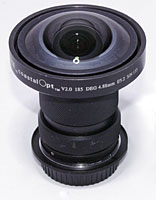
What is this strange monster? Midway between an FC-E8 Nikon converter and an 8mm f2.8 Nikkor Fisheye dream, it is, however NOT a cheap fisheye, and NOT a crappy converter. First of all, when I got it in my hands it was the ONLY real circular fisheye lens made for an APS-C sensor, secondly it delivers outstanding quality. Well, it was an expensive lens.
In these pictures, you can see it on a hand, and also on a film Nikon camera, I did it to allow you to evaluate its size, the lens was NOT MADE for 24×36 film cameras.
Coastal offered it in Nikon and EOS mount, but at a closer inspection, it seems to have a standard T2 mount.
This means Pentax, Minolta-Sony, and probably Sigma compatibility, as well as 4/3 and all mirrorless.
It has no focusing control, no aperture settings, you have to work hyperfocal at f/5.2
This came from Coastal in order to allow AGNOS to develop a ring panohead for it. I cannot grant this to be a standard production piece, that looks quite different in the mounting zone from the online images available. However, the Nikon adapter it was supplied was really nothing special, not really tight to the camera and without an anti-twist mechanism. It jammed on the AI-S pin of the Nikon 301 (a Nikon bayonet pin adopted in all cameras with T and P modes, from FA till some modern film AF ones) compelling me to do some magic ritual to remove it from the camera.
What’s the place of this lens in the universe and in the market?
Well, when it hit the market it was a $4.000 lens, without diaphragm and focusing, two things that maybe are not so necessary. (now in 2021 they ARE, because of higher resolution sensors)
One of the uses was surely to shoot the 2-hemisphere panoramic pictures in the best quality possible (it sports a 185 degrees circle, and many versions were sold under IPIX brand!) the other could be measurements, surveys, scientific use, like a cloud camera. This lens in fact claims to record a perfect equisolid geometry. The other way to do it is to use a full-frame digital sensor, with another outstanding quality circular fisheye, but I’m not so sure that would be the right solution, especially if you want to use hi-grade custom video sensors.
The image in the viewfinder is bright and crisp, usable till the very end, with negligible vignetting, no color separation at borders, and controlled flare. This is a really well-made optic! Well, but a diaphragm AND a focusing helicoid…
I’m looking forward to some info on this lens history. First of all the exact market introduction date…







